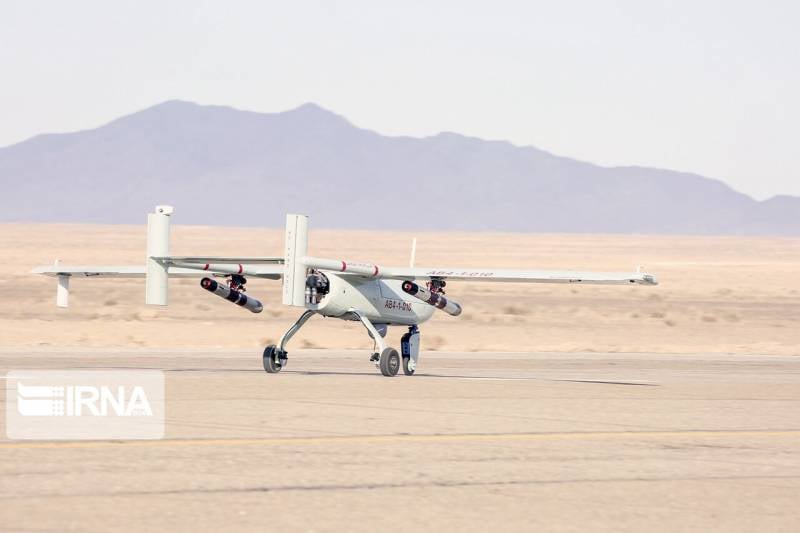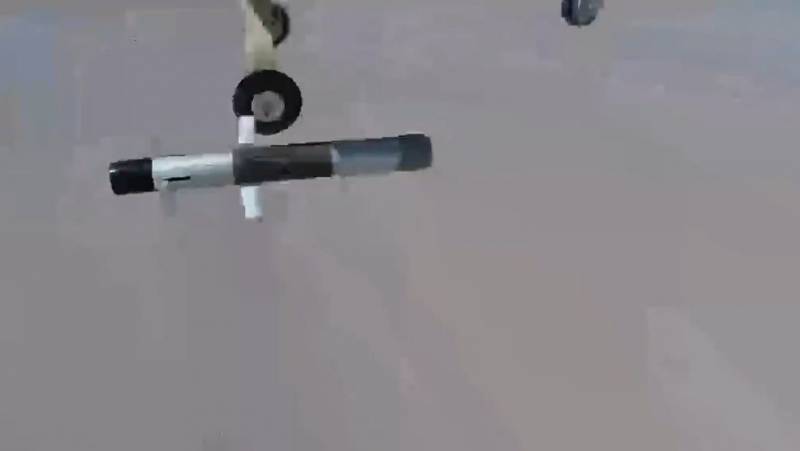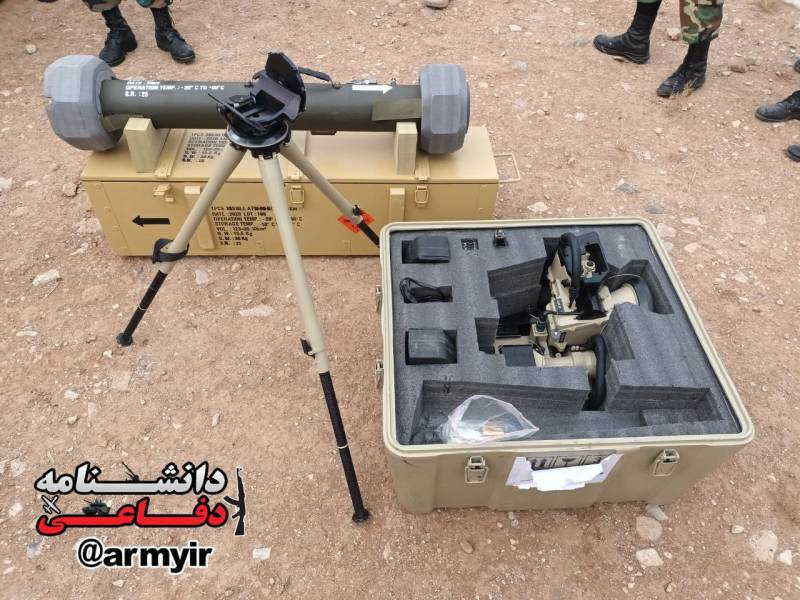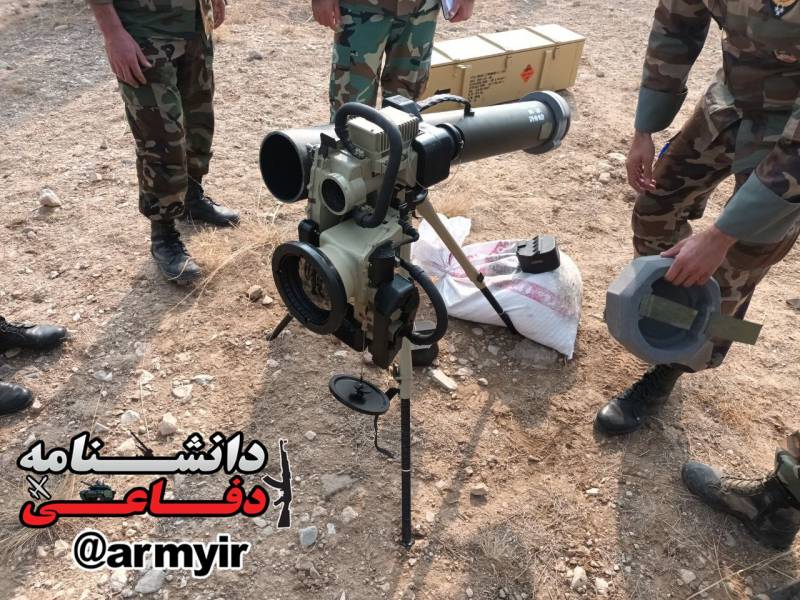Iranian Almaz missile systems

Ababil-3 UAV with a pair of Almaz missiles, 2021. Photo by IRNA
Despite all the difficulties and restrictions, the Iranian defense industry is developing and producing a wide range of missile weapons. Thus, a few years ago the Almaz light guided missile was created. It is equipped with a full-fledged homing head and is intended for use as part of unmanned aerial vehicles. aviation systems and man-portable anti-tank missile systems.
Aircraft rocket
According to known data, the Almaz guided missile was created in the second half of the XNUMXs by order of the Iranian Ministry of Defense. The development organization is not reliably known, but it can be assumed that it was one of the leading enterprises in Iranian industry. Apparently, by the end of the decade, all preliminary tests and refinement of the design had been carried out.
The new ammunition was first demonstrated to the public in July 2020 as part of a ceremony to hand over new equipment to the armed forces. At the event, interesting footage was shown from tests of the Ababil-3 strike UAV, which carried and used a previously unknown missile. Later Drones of this type with similar weapons were included in other reports.
The promising missile was officially presented to the public only at the beginning of 2021. It was reported that the product was named “Almaz” and is a light air-to-surface guided missile with a flight range of 8 km. Other characteristics and development prospects of the product were not specified, but one could expect that the missile would go into large production and take its place in the arsenals of unmanned aircraft.
Infantry weapons
At the same time, rumors appeared about the possible development of the existing rocket with the creation of a new modification, incl. for transfer to other platforms. In particular, it was assumed that it would be possible to develop a portable / transportable anti-tank missile system for ground forces based on Almaz.

Testing of the Almaz product. Photo Imp-navigator.livejournal.com
A few months later, in July 2021, these assumptions were confirmed. Iran hosted another solemn ceremony for the transfer of new defense industry products to the armed forces, during which an exhibition was held with a demonstration of known and new models. At this event, the expected ATGM with a missile from a UAV, designated Almaz-1, was shown for the first time.
Soon after, Iranian industry and the military began regularly demonstrating new missile systems at various events and in public publications. In search of potential clients, they are even shown at foreign exhibitions. For example, in recent years, these products and promotional materials about them have been present at Russian Army forums.
Missiles in service
According to various sources, the basic model of the Almaz family of weapons has already been adopted by Iranian unmanned aircraft units, both in the army and in the Islamic Revolutionary Guard Corps. Its main carriers are reconnaissance and attack UAVs of the Ababil line, which have the required dimensions and carrying capacity. There is probably a fundamental possibility of application on other platforms with the required level of characteristics.
In 2021, the Iranian armed forces received the first portable Almaz-1 systems. Probably, by this time mass production had been established, and now the army and the IRGC regularly receive such weapons. In addition, it constantly appears in reports from various exercises and other events.

First display of the portable ATGM "Almaz-1", 2021. Photo by Fars News
There is no information yet on export deliveries of the two versions of Almaz. Iran does not officially disclose this type of information, and foreign intelligence services and the press are unable to obtain it from their sources. However, two types of guided missiles are actively promoted on the market, and one can expect the signing of contracts or the appearance of missiles abroad without prior announcement.
Common rocket
The Almaz family of complexes is based on a guided missile of the same name. Aviation and land complexes use two modifications of this product with the maximum possible unification of the design. Due to certain differences and changes, compatibility with different platforms is ensured and new capabilities are achieved.
The Almaz guided missile is made in a cylindrical body with a diameter of 130 mm and a length of 1,1 m. The launch weight of the product is up to 15 kg, depending on the complex used. The missile has a transparent head fairing, under which a homing head is placed. Behind it are the warhead, solid propellant engine, controls, etc.
In the middle and rear parts of the hull there are longitudinal trays for placing folding stabilizers and rudders. After being dropped from the carrier or exiting the launch container, the planes unfold and perform their task.
The aviation and land versions of the Almaz missile are equipped with an optical-electronic homing head without specifying a specific type. Probably an infrared system is used. Before launch, it tracks the target selected by the operator and then automatically aims the missile, thanks to which the “fire-and-forget” principle is implemented. This seeker allows you to attack contrasting stationary and moving targets.

Elements of the Almaz-1 complex during assembly. A TPK with a missile is placed on a tripod. The command and launch unit remains in the container for transportation. Photo Telegram / ArmyIR
The Almaz-1 complex uses a rocket with additional control equipment. It is distinguished by the presence of a reel with a fiber optic cable and the ability to maintain two-way communication with the operator. In this case, the “launch-evaluate-forget” mode is added to the “launch-evaluate-forget” mode - the operator gets the opportunity to correct the missile’s flight or redirect it to another object within a certain sector.
The missiles are equipped with a tandem cumulative warhead with a penetration capacity of at least 600 mm of armor behind dynamic protection. A thermobaric warhead has also been announced, replacing the high-explosive fragmentation projectile of a large caliber.
Apparently, both versions of the Almaz are equipped with one solid fuel propulsion engine. At the same time, different flight characteristics are provided. So, when launched from an aerial platform, depending on the speed and height of the release, the missile range reaches 8 km. The land-based ATGM missile has half the range.
The aircraft version of the rocket is used with a beam holder of the appropriate size and load capacity, compatible with the used aerial platform. In addition, the carrier drone must have appropriate control devices on board. In this case, the function of the missile system control panel is performed by the operator station on the ground.
The Almaz-1 portable ATGM includes a missile in a fiberglass transport and launch container. Before use, the TPK is connected to the command and launch unit. From the point of view of architecture and ergonomics, such a complex is similar to some modern foreign models - the American FGM-148, the Chinese HJ-12, etc. The block has a fairly large mass, 11,5 kg, which is why it is proposed to use a tripod for the assembled complex.

"Almaz-1" in combat-ready form. Photo Telegram / ArmyIR
The command and launch unit has television and thermal imaging optical channels, as well as electronics for video signal processing and missile control. Provides an overview of the area and search for targets, followed by tracking and launching a missile. There are two shooting modes with their own advantages.
Modern technology
Thus, Iran continues to develop its own guided missiles and regularly shows new interesting results from this process. In 2020-21 These results were a new guided missile for hitting ground targets and two missile systems capable of using it. To date, the Almaz series complexes have been adopted and entered into production.
The Almaz project is of interest for several reasons. Thus, it shows the ability of Iranian industry to develop modern guided weapons for aviation and ground forces. In terms of functions and declared characteristics, this product is not inferior to the main foreign representatives of the same class.
In addition, the Almaz series projects implement an interesting idea of unifying guided munitions for fundamentally different carriers. The new guided missile was first introduced as an air-to-surface weapon, and then a portable ground-based complex was created for it. In both cases, it is possible to realize the technical potential of the design and obtain the desired results.
As a result, the Iranian armed forces, represented by the ground forces, the air force and the IRGC, received modern guided weapons capable of solving various combat missions and hitting a wide range of ground targets. In addition, Iranian industry is already looking for foreign customers and there is little doubt in Almaz’s ability to find new buyers. All this can already be considered a success and proof of the high potential of Iranian industry.
Information